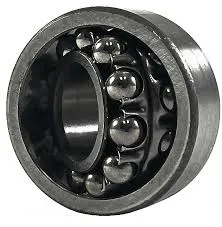
Dic . 04, 2024 16:59 Back to list
angular contact ball bearing contact angle
Understanding Angular Contact Ball Bearings and Their Contact Angle
Angular contact ball bearings are crucial components in various mechanical systems, providing efficient rotation and support for radial and axial loads. Unlike traditional radial ball bearings, which are designed to support only radial loads, angular contact ball bearings are engineered to handle both radial and axial loads, allowing them to be used in more demanding applications.
What is Contact Angle?
The contact angle in angular contact ball bearings refers to the angle between the line of action of the load and a line perpendicular to the bearing's axis. This angle is a critical design factor because it influences the bearing's performance characteristics, including its load-carrying capacity, stiffness, and overall stability.
Typically, angular contact ball bearings are categorized based on their contact angles, which can range from 15 degrees to 40 degrees. The most common angles are 15°, 25°, and 40°. Each of these angles provides different performance attributes that make them suitable for various applications.
Importance of the Contact Angle
1. Load Handling Capacity A larger contact angle allows the bearing to accommodate higher axial loads. This is particularly important in applications where the bearings must support significant thrust forces, such as in gearboxes, spindles, and motor shafts. For instance, a bearing with a contact angle of 40° can manage axial loads effectively, making it ideal for heavy-duty applications where both radial and axial loads are present.
2. Stiffness and Rigidity The contact angle also affects the overall stiffness of the bearing. A steeper contact angle results in increased rigidity, making the bearing less prone to deformation under load. This is crucial for precision applications, such as in machine tools and robotics, where maintaining tight tolerances is vital for performance.
angular contact ball bearing contact angle

3. Friction and Heat Generation The contact angle influences the frictional characteristics of the bearing. A higher contact angle can lead to increased friction, which may result in higher operating temperatures. Therefore, engineers must balance load capacity and heat generation when selecting the appropriate contact angle for a specific application.
Application of Angular Contact Ball Bearings
Angular contact ball bearings are extensively used in various industries, including automotive, aerospace, and manufacturing. Here are a few key applications
- Machine Tools In precision machining, angular contact bearings provide the necessary support for spindle operations, ensuring high speed and accuracy while handling substantial axial loads.
- Electric Motors These bearings are often found in electric motors, allowing them to operate efficiently under both radial and axial loading conditions, which helps in minimizing vibration and enhancing performance.
- Gearboxes In gearbox applications, the ability to handle thrust loads is vital. Angular contact ball bearings are commonly utilized to support the shafts and improve overall gearbox efficiency.
Conclusion
In summary, angular contact ball bearings play a vital role in modern engineering, allowing for the efficient management of both radial and axial loads. The contact angle is a key factor in determining a bearing's performance characteristics, influencing load capacity, stiffness, and friction levels. Understanding the importance of the contact angle helps engineers choose the right bearing for their specific applications, ensuring optimal performance and reliability in their systems. Whether in high-speed machinery or heavy-load applications, angular contact ball bearings are essential for the smooth operation of various mechanical systems.
Latest news
-
Grooved Ball Bearing Design and Functionality
NewsJun.04,2025
-
Concrete Mixer Bearing Load Capacity Testing
NewsJun.04,2025
-
6004 Bearing Dimensions in Robotic Joint Designs
NewsJun.04,2025
-
Advantages of Single-Row Deep Groove Ball Bearings
NewsJun.04,2025
-
Applications of Deep Groove Ball Bearings in Automotive Systems
NewsJun.04,2025
-
Innovations in Bearing Pressing Machine Design
NewsJun.04,2025
